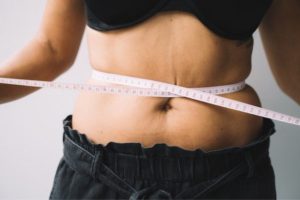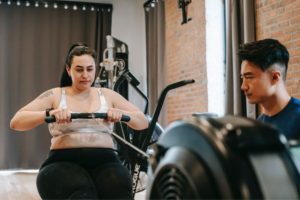Have you ever glanced in the mirror and felt like you appear heavier than what the scale tells you?
It’s a common phenomenon many people experience, but understanding its reasons is crucial for maintaining a healthy body image.

Let’s explore the various reasons why you might look heavier than your actual weight and offer solutions to help you feel more confident in your appearance.
By understanding these factors and implementing some of our suggested solutions, you can learn to love and embrace your body as it is.
Reasons Why You Might Weigh Less Than You Look
Muscle Mass
Two different types of tissues in the body are muscles and fat, with muscle being denser and heavier than fat.
In other words, one pound of fat takes more space as compared to an equal weight of muscle.
Therefore, even if two people weigh the same, the person with more muscle mass will typically have a leaner appearance.
In comparison, someone with more body fat will look rounder and softer.
This is why someone with much muscle mass might look heavier than someone with less muscle but weigh less.
For example, a bodybuilder who weighs 180 pounds might appear to weigh over 200 pounds due to their significant muscle mass.
On the other hand, someone who weighs the same but has a higher percentage of body fat might look softer and less toned, giving the illusion of a higher weight.
It’s important to note that muscle mass benefits overall health and boosts metabolism, making weight management easier.
Therefore, if you want to improve your body composition and appear leaner, strength training and building muscle should be a priority.
Increasing your muscle mass can achieve a more toned and defined physique while weighing less.
Water Retention
Water retention, also known as edema, is where excess fluids accumulate in the body’s tissues, leading to swelling and puffiness.
This condition can occur anywhere in the body, but it’s commonly seen in the hands, feet, ankles, and legs.
Various factors, including poor diet, hormonal imbalances, pregnancy, and certain medical conditions, can cause water retention.
Water retention can cause someone to look heavier than their actual weight because the excess fluids add extra weight to the body.
This can be particularly noticeable in areas where water retention is most common, such as the ankles or legs.
The swelling can also make someone look puffy and bloated, giving the impression of a higher weight.
Diet can be a significant contributor to water retention. Consuming high amounts of salt can cause the body to retain water, which can lead to swelling and bloating.
Additionally, dehydration can lead to water retention, as the body tries to hold onto fluids to prevent further dehydration.
Certain medications, such as blood pressure and steroids, can also cause water retention as a side effect.
To reduce water retention, it’s important to identify and address the underlying cause.
This may involve adjusting your diet to reduce salt intake, staying hydrated, and speaking with a healthcare provider about medication adjustments.
Additionally, activities such as exercise and massage can help to promote lymphatic drainage and reduce swelling.

Body Shape
Body shape is an important factor that can affect how someone appears, even if they have the same weight and height as someone else.
The distribution of body fat and muscle mass can vary dramatically between individuals, resulting in different body shapes.
Common body shapes include apple, pear, hourglass, and rectangle.
Someone with a more compact physique, such as an apple shape, may appear heavier than someone with a longer, leaner body, such as a rectangle shape.
This is because people with an apple shape are more likely to carry more weight around their midsection, making their torso appear wider and rounder.
Additionally, people with a compact body shape may have shorter limbs, which can give the impression of being more stocky.
In contrast, someone with a longer, leaner shape may appear slimmer even if they weigh the same as someone with a more compact shape.
For example, people with a rectangle or hourglass shape tend to have longer limbs and a more balanced distribution of body fat, which can create a more elongated and streamlined appearance.
It’s important to note that body shape is largely determined by genetics, and while it can affect how someone appears, it doesn’t necessarily reflect overall health or fitness.
Instead of focusing on achieving a certain body shape, it’s more important to prioritize healthy habits such as regular exercise, balanced nutrition, and adequate sleep to maintain overall health and well-being.
Clothing
Clothing can greatly impact looks and even create the illusion of a different body shape. The cut, style, and fabric of clothing can all play a role in how someone appears.
In particular, heavier clothing can make someone appear heavier than their actual weight.
This is because the extra weight of the clothing can pull and drag on the body, causing it to appear wider and more rounded.
Additionally, heavier fabrics can add bulk to certain body parts, such as the thighs or arms, which can give the impression of a higher weight.
On the other hand, wearing form-fitting clothing can create a more streamlined and elongated appearance.
Clothes that fit properly and hug the body in the right places can create the illusion of a more toned and defined physique, even if the person has a higher body fat percentage.
It’s important to note that while clothing can impact how someone looks, it’s not necessary to prioritize fitting into a certain size or style of clothing.
Instead, focus on finding clothing that makes you feel confident in your own skin.
Additionally, wearing clothing that fits properly is important, as ill-fitting clothing can create the opposite effect and make someone appear larger than their actual weight.
Tips to Help You Feel Better About Your Appearance

Strength Training
Strength training is an effective way to build muscle mass, which can help improve body composition and overall appearance.
When you engage in regular strength training exercises, it can create small tears in your muscle fibers.
As these fibers repair themselves, they become stronger and thicker, increasing muscle mass.
Some examples of strength training exercises include weightlifting, bodyweight exercises, and resistance band workouts.
Weightlifting exercises include bench presses, squats, deadlifts, and bicep curls. Bodyweight exercises like push-ups, pull-ups, and squats, use your own body weight as resistance.
Resistance band workouts involve using stretchy bands to create resistance during exercises such as rows, curls, and presses.
Dressing for Your Body Type
One of the easiest ways to feel better about your appearance is to dress for your body type.
Different body types have different proportions, and certain styles of clothing can be more flattering for different shapes.
For example, if you have a pear-shaped body, you may want to wear tops that draw attention to your upper body and pants or looser skirts around the hips and thighs.
Here are some general tips for dressing for your body type:
- Apple-shaped: Wear clothes that cinch at the waist to create a more defined waistline, and avoid clothing that is too tight around the midsection.
- Pear-shaped: Wear clothes that draw attention to your upper body, such as V-neck tops, and choose looser pants or skirts around the hips and thighs.
- Hourglass-shaped: Wear clothes accentuating your curves, such as form-fitting dresses or high-waisted pants.
- Rectangle-shaped: Wear clothes that create the illusion of curves, such as peplum tops or A-line skirts.
Drinking More Water
Water retention can commonly cause feeling heavier than your actual weight.
When your body retains excess water, it can cause bloating and swelling, making you appear heavier.
Drinking more water can help reduce water retention. When dehydrated, your body holds onto more water as a survival mechanism.
By drinking enough water, you signal to your body that releasing excess water is okay.
The amount of water someone should drink can vary based on weight, activity level, and climate.
However, a general guideline is drinking at least 8 glasses of water daily. Staying hydrated includes improved digestion, clearer skin, and increased energy.
Eating a Balanced Diet
Eating a balanced diet can help maintain a healthy weight and body composition, which can help you feel better about your appearance.
A balanced diet includes a variety of whole foods such as fruits, vegetables, whole grains, and lean protein.
These foods provide essential vitamins, minerals, and nutrients your body needs to function properly.
Here are some tips for incorporating more whole foods into your diet:
- Eat a variety of colorful fruits and vegetables to get a range of nutrients.
- Choose whole grains such as brown rice, quinoa, and whole wheat bread.
- Choose lean protein sources such as chicken, fish, beans, and tofu.
- Limit processed foods and sugary drinks.
By eating a balanced diet, you’ll feel better physically and mentally, as a healthy diet can improve mood and overall well-being.

When I was in high school, I was the best at running. Running for me is not a trend, this is my whole life. I jog every morning, without exceptions: I don’t skip mornings on vacations or business trips. My friends are also sports fans: I went to my best friend’s yoga class for the first time about three years ago.
Since then, I’ve been practicing regularly, and we have also made several yoga trips to India. For my last birthday, I got a skateboard as a present from her. Now we’re both taking personal classes with a coach, and it’s 100% fun!





